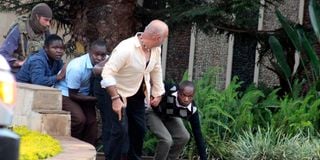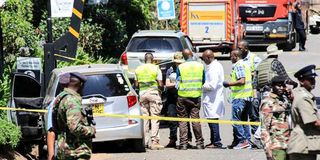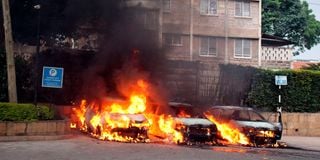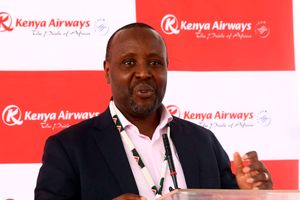Premium
DusitD2 Hotel attack: The lingering questions

A scene of the evacuation from Dusit D2 Hotel that was attacked by terrorists on January 15, 2019.
Four years ago, an otherwise quiet road leading to one of the most exclusive areas on the west side of Nairobi was converted into a theatre of explosions, fire, gunshots and death.
From 3.28 pm that day, a terror attack unravelled that in the end left 22 victims dead and several others injured.
Litres upon litres of water have since flown down the river that gives the road its name — 14 Riverside Drive.
The complex that was attacked reopened in August 2019, six months after the attack.
The trail of the trials of the seven people who were charged following the attack went cold at some point, and it is life as usual. However, some questions still linger.
1. What became of the plan to arm security guards?
Following the DusitD2 attack, the government said it would allow security guards, who are the first point of contact in most establishments, to be armed. The last time this was talked about, firms were being vetted before private security firms could be allowed to arm their guards. It is unclear whether a January 3 gazette notice that identified 183 firms as the only ones cleared to be in business is related to that proposal.

Kenya forensic officials with the help of US Federal Bureau of Investigation (FBI) officials collect evidence from a vehicle believed to have been used by the terrorists before they attacked DusitD2 complex on Riverside Drive in Nairobi on January 17, 2019.
Security consultant Isaiah Mugambi told the Sunday Nation: “Security guards are usually the first point of contact with terrorists. Do we equip them? Do we train them? Are they well-trained to counter any attack? Have we built safe havens for them where somebody can hide and report?”
2. How many of the plotters were arrested?
With last week’s announcement of a $10 million bounty on the head of Mohamoud Abdi Aden, the suspected mastermind, questions linger on how many people directly involved in the attack were apprehended. The American embassy said Mohamoud was part of the cell that planned the onslaught.
A November 2019 report by United Nations (UN) experts said the attack was executed by three Kenyans and two Somalis. The three Kenyans were Ali Salim Gichunge and his ally Osman Ibrahim Gedi and Mombasa-born Mahir Khalid Riziki, who blew himself up in the initial stages of the attack.
Of the two Somalis, the report named one — Siyat Omar Abdi, a Somali born in the Dadaab refugee complex in 1992. Who is the unnamed Somali? Also, might Mohamoud be the Kenyan citizen based in Mandera who served as a key financing link as per the UN report?
3. What became of Violet Kemunto?
In the images of wanted terror suspects released by the Directorate of Criminal Investigations last week, some of the names that have been on the wanted list from years back were listed. But that of Violet Kemunto – who was married to attacker Ali Salim Gichunge and who is believed to have fled Kenya days before the dusitD2 attack – was absent. Is it possible she was apprehended and silently eliminated or the authorities just gave up on her?
4. Will Kenya ever compensate those terrorism victims?
Mr James Ndeda, the director of the Victims of Terrorism Organisation Kenya, says it is time Kenya sought ways of giving financial aid to victims of terror attacks like the US does.
“There are so many people I know who are still languishing in poverty and there is no compensation from the Kenyan government. People are suffering,” he told the Sunday Nation.

Vehicles in flames at the scene of the terror attack at Dusit D2 Hotel on January 15, 2019.
“We want Kenya to follow the example of the US and compensate its victims. Many of them are still suffering,” he said.
5. Have the number plate loopholes been sealed?
One of the major security loopholes identified during the DusitD2 attack was that a car that the attackers used had number plates similar to those of another vehicle in Kitengela. About 10 days after the attack, anti-terror police raided the offices of the National Transport and Safety Authority (NTSA) offices as investigations went on.
Fast-forward to August 2022 when new-generation number plates were launched.
“We were attacked especially because terrorists gained registered vehicles and acquired number plates and it was very difficult to trace those people within the time they were around,” Interior Cabinet Secretary Fred Matiang’i said during the launch.
The government said the issuance of the new plates is being supervised by a multi-agency team drawn from the National Intelligence Service, the Prisons Department, the NTSA and the police.
However, with past reports that unscrupulous NTSA officials had formed a racket that fraudulently cloned number plates in exchange for bribes, is the new system any better?





